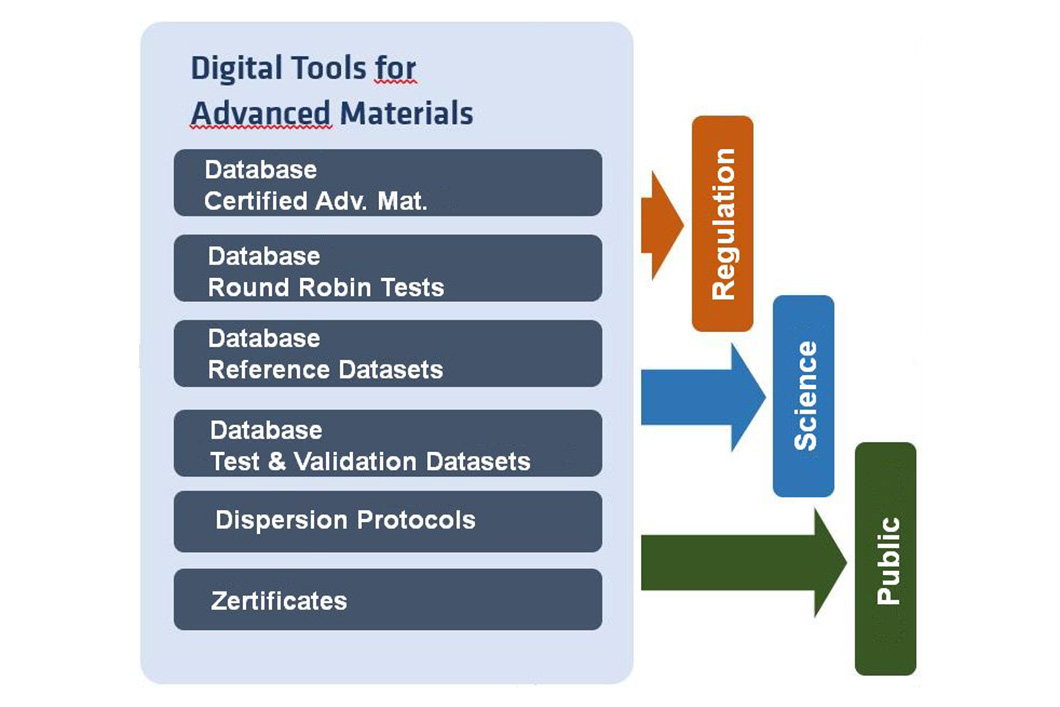
Source: BAM
The Data, Digital Tools & Safety of Advanced Materials division focuses on the sustainable and safe development, use, and documentation of innovative materials, including nanomaterials. The integration of digital tools, structured data, and safety-oriented design principles is crucial for developing advanced materials in a responsible, efficient, and future-proof manner. Each of these aspects contributes to promoting innovation and sustainability and ensuring safety for people and the environment.
Sustainability and safety
Sustainability is a key goal in the development of advanced materials in order to minimize environmental impact and use resources efficiently. Safety includes minimizing potential risks to people and the environment in production, handling, and through the interaction of materials with biological ecosystems. Safe materials form the basis for a sustainable cycle system.
SSbD (Safe and Sustainable by Design)
The Safe and Sustainable by Design (SSbD) concept ensures that new materials are designed during the development phase to be both safe and sustainable throughout their entire life cycle. This reduces risks and supports compliance with regulatory requirements by identifying and avoiding potential hazards at an early stage.
Ecodesign Directive
The EU Ecodesign Directive requires that products – including materials – are designed to be resource-efficient, repairable, and, in particular, recyclable throughout their entire life cycle. It is an important driver for sustainable innovation and promotes the development of more environmentally friendly and recyclable products.
Digital Product Passport (DPP) / Material Passport (DMP)
The Digital Product Passport (DPP) documents the composition, origin, properties, and sustainability aspects of products throughout their entire life cycle. The Digital Material Passport (DMP) forms the basis for the DPP, enabling transparency along the value chain, supporting the circular economy, and facilitating the traceability and recycling of materials.
Ontologies
Ontologies structure knowledge in materials science by formally defining terms, properties, and processes. They enable the integration and exchange of data between different databases and digital tools and are essential for the interoperability and automation of data-based processes.
Data management with BAM Datastore
Efficient data management using the BAM Datastore ensures the structured collection, storage, and management of experimental and analytical research data. This ensures the quality, integrity, and findability of the data, enables its reuse, and forms the basis for the traceability of research data, reproducible science, and the use of modern digital tools such as AI and machine learning.
Development of digital reference methods
The data management concept enables BAM to create standardized digital evaluation routines and anchor them as reference methods in the EU Test Methods Regulation. The EU Test Methods Regulation specifies the permissible methods for obtaining data for the registration of new materials under REACH. This gives the designated test methods (e.g., OECD TG 125) a central role in the Ecodesign Directive and the “Safe and Sustainable by Design (SSbD)” concept.
AI/ML methods (artificial intelligence/machine learning)
Artificial intelligence and machine learning accelerate the development and optimization of advanced materials by analyzing large amounts of data, recognizing patterns, and enabling predictions about material properties or behavior. They help to shorten development times and find innovative solutions.
Together with other federal authorities, it advises policymakers and NGOs and conducts various approval procedures for nanomaterials and other advanced materials. BAM focuses in particular on the physical and chemical standards for measurement methods and reference materials. Cooperation with industry and science is particularly important to us. Please contact us for more information.
The background paper on nanosafety provides examples of information on the following aspects:
- Emissions and detection in the environment
- Aging and disposal of nanomaterials
- Interaction of biology with nanomaterials
The background paper on nanodata provides information on the following aspects:
- Nanodata, reference data
- Nano reference database, nano SOP database
- Nano reference algorithms


